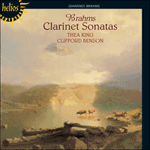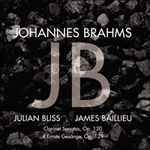
Welcome to Hyperion Records, an independent British classical label devoted to presenting high-quality recordings of music of all styles and from all periods from the twelfth century to the twenty-first.
Hyperion offers both CDs, and downloads in a number of formats. The site is also available in several languages.
Please use the dropdown buttons to set your preferred options, or use the checkbox to accept the defaults.

| Julian Bliss (clarinet), James Baillieu (piano)» More |
The other two movements are markedly contrasted with each other. The scherzo, Allegro appassionato, is in E flat minor and begins in a flowing vein that at first seems to follow easily what has gone before – but it becomes intense and full of measured energy, and there is a trio in B major, one of Brahms’s most splendid melodies. In the third movement, Andante con moto, he relaxes into five variations and coda on a beautiful theme that shows no inclination to activity until a stormy variation interrupts in E flat minor. But the sun soon comes out again, and the sonata ends happily, as it began.
from notes by Robert Simpson © 1986
Les deux autres mouvements présentent de forts contrastes. Le scherzo, Allegro appassionato, en mi bémol mineur, s’ouvre sur une veine fluide, a priori aisément conforme à ce qui précède – mais bientôt, il devient intense, tout en énergie contenue, avant un trio en si majeur, l’une des plus splendides mélodies de Brahms. Dans le troisième mouvement, Andante con moto, le compositeur se détend à travers cinq variations et une coda sur un thème magnifique, dépourvu de toute inclination pour une quelconque activité jusqu’à ce qu’une variation tempétueuse ne vienne l’interrompre en mi bémol mineur. Mais le soleil réapparaît bientôt et la sonate s’achève comme elle avait commencé, dans le bonheur.
extrait des notes rédigées par Robert Simpson © 1986
Français: Hypérion
Die anderen beiden Sätze sind recht gegensätzlich angelegt. Das Scherzo, Allegro appassionato, steht in es-Moll, beginnt recht fließend und scheint an das Vorhergegangene direkt anzuschließen, jedoch nimmt es an Intensität zu und entwickelt eine gemessene Energie. In dem Trio in H-Dur ist eine der schönsten Brahmsschen Melodien zu hören. Im dritten Satz, Andante con moto, lässt die Intensität etwas nach und es erklingen fünf Variationen mit Coda über ein wunderschönes Thema, das zwar zunächst nicht auf Lebhaftigkeit schließen lässt, dann aber von einer stürmische Variation in es-Moll unterbrochen wird. Bald darauf kommt aber die Sonne wieder heraus und die Sonate endet so heiter wie sie begonnen hatte.
aus dem Begleittext von Robert Simpson © 1986
Deutsch: Viola Scheffel
 Brahms: Clarinet Sonatas Brahms: Clarinet Sonatas‘Really, I have only two words to say about this disc—'Buy it!' (BBC Record Review)» More |
 Brahms: Clarinet Sonatas & Vier ernste Gesänge Brahms: Clarinet Sonatas & Vier ernste GesängeTwo of the finest chamber musicians around today revel in the supreme craftsmanship of Brahms's sublime clarinet sonatas—works inspired by the great clarinettist Richard Mühlfeld whose Mozartian brilliance coaxed the composer out of retirement to ...» More |

